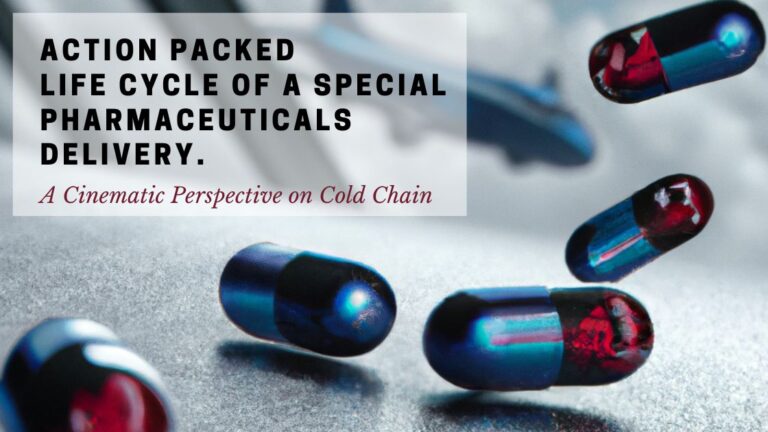From Laboratories to Life Lines. The Epic Journey of Special Pharmaceutical Deliveries.
- Mettcover Global

The Plot – Why Cold Chain Management?
In a world where even a temperature rise of one degree can create a havoc and time is the ultimate enemy. This is indeed a riveting saga of the Special Pharmaceutical Delivery, a high-stakes action-packed adventure that defies the boundaries of temperature and tests the limits of human ingenuity and Cold Chain excellence.
To understand the magnitude of the challenges faced in the special pharmaceuticals delivery sector, let’s examine some key statistics. In the United States alone, it is estimated that around 30% of pharmaceutical products require temperature-controlled transportation. Similarly, in Europe, a significant portion of pharmaceuticals, including vaccines and biologics, necessitate stringent temperature management.
The Twist – Supply Mission Impossible
To transport these precious cargos to their destinations, unscathed and unaltered, ensuring their potency remains intact.
But lurking in the shadows are the challenges that threaten to unravel this delicate operation. Temperature fluctuations, the arch-nemesis of stability, lie in wait at every turn. The cold chain, a treacherous path filled with icy perils and scorching hurdles, must be navigated with unwavering precision. As the climax nears, tables are set, and the final act unfolds. Shipping labels adorned with temperature profiles become the guiding beacons, illuminating the path for various product types. From vaccines to biologics, their unique temperature requirements must be met with unwavering precision. These tables, these keys to unlocking success, become the heartbeat of the operation.
In this high-octane action story of the life cycle of a Special Pharmaceutical Delivery, we first hand witness the legend (of temperature control). It is a tale of suspense, precision, and the unyielding human spirit. So fasten your seatbelts and prepare for a cinematic experience like no other as we dive into the exhilarating world of Special Pharmaceutical Deliveries.
A Medicine is Born. Praise to the Scientist
The epitome of human innovation is exemplified in the laboratories of cutting-edge pharmaceutical companies, where groundbreaking medicines are born. Brilliant minds toil tirelessly, crafting potent concoctions that hold the power to heal and transform lives. But these life-saving elixirs are delicate, vulnerable to the whims of temperature, requiring utmost care and precision in their journey to the hands of those in need.
The Beacons of Hope – Pallet Shipping Labels
As the odyssey begins, pallet shipping labels adorned with specific temperature profiles become the guiding beacons, illuminating the path for various product types. From vaccines to biologics, their unique temperature requirements must be met with unwavering precision. These tables, these keys to unlocking success, become the heartbeat of the operation.
To illustrate the complexity of temperature control, let’s examine popular shipping label temperature profiles for special pharmaceutical deliveries and their corresponding product types:
Table 1: Shipping Label Temperature Profiles
| Temperature Range | Product Type |
| 2-8°C | Refrigerated Medicines |
| 15-25°C | Controlled Room Temperature Medications |
| -20°C | Frozen Medications |
| -70°C | Ultra-Frozen Drugs |

Enter the Heroes of Temperature Control
The active and passive insulation warriors. Active insulation, armed with sophisticated refrigeration systems, stands as a stalwart guardian, tirelessly battling the forces of heat and cold. Meanwhile, passive insulation, Advanced Insulation Materials, are a powerful force, harnessing the innate properties of materials to create thermal fortresses, shielding the precious cargo from the whims of the environment.
Temperature excursions pose a significant risk to the integrity of temperature sensitive pharmaceuticals. These excursions occur when products are exposed to temperatures outside the specified range, leading to potential degradation and loss of efficacy. To combat this challenge, the industry relies on both active and passive insulation techniques.
Passive insulation Cold Chain Packaging involves the use of advanced insulation materials like the Mettcover X Pro X and X Pro A, which are designed to provide exceptional thermal resistance. These materials possess high R-values, indicating their ability to resist heat transfer. The R-value quantifies the thermal resistance of a material, with higher values indicating superior insulation performance. By selecting insulation materials with high R-values, we can minimize heat transfer and maintain the desired temperature range, safeguarding the potency of special pharmaceutical deliveries.
Amidst the epic journey, our heroes must overcome the harrowing challenges of transportation and storage. The battle for temperature integrity rages on, as every moment counts. From the darkest depths of frigid cargo holds to the sweltering heat of tarmacs, the Special Pharmaceutical Delivery must brave the elements, emerging unscathed and victorious.
The Unsung Heroes of Cold Chain Management
But what of the orchestration behind the scenes? The unsung heroes known as the 1PL, 2PL, 3PL, 4PL, and 5PL logistics warriors step into the spotlight. With their strategic planning and unwavering dedication, they ensure the seamless transition of the Special Pharmaceutical Delivery through every stage of its journey. From procurement and warehousing to transportation and distribution, their expertise becomes the backbone of this adrenaline-fueled operation.
Uncut Scenes
The journey of a special Pharmaceutical Delivery, starting from the laboratory and culminating at the medical center. At each stage, temperature control is crucial to preserve the efficacy of the products.
Laboratory: This is where the special pharmaceutical delivery is carefully prepared and packaged, ensuring proper temperature control from the outset. Lab technicians work meticulously to maintain the required temperature range, often using cold storage facilities and refrigerated containers to safeguard the products.
Transportation: Once the special delivery leaves the laboratory, it enters the realm of logistics. Various players come into play, including 1PL, 2PL, 3PL, 4PL, and 5PL providers. These logistics partners play vital roles in ensuring the smooth and efficient transportation of the products. They carefully monitor temperature conditions, track shipments, and implement contingency plans to address any unforeseen challenges.
Warehousing: At warehouses and distribution centers, special attention is given to temperature control. State-of-the-art storage facilities equipped with temperature monitoring systems ensure that the products remain within the desired temperature range. Automated inventory management systems and real-time tracking further enhance the efficiency of the process.
Last-Mile Delivery: Finally, the delivery reaches the medical center, where healthcare professionals eagerly await its arrival. The journey’s success hinges on the collective efforts of all the logistics partners involved, ensuring that the products remain safe and effective until the last mile.
Table 2: Roles of Logistics Providers
| Stage | 1PL | 2PL | 3PL | 4PL | 5PL |
| Laboratory | Temperature Control | Packaging | Quality Assurance | Cold Chain Planning | Regulatory Compliance |
| Transportation | Route Planning | Shipment Tracking | Temperature Monitoring | Risk Management | Vendor Management |
| Warehousing | Inventory Management | Storage Facilities | Order Fulfillment | Data Analytics | Lean Operations |
| Last-Mile | Delivery Optimization | Customer Satisfaction | Reverse Logistics | Continuous Improvement | Performance Metrics |

The Rocket Science of Cold Chain Packaging
Amidst the chaos, two enigmatic concepts, the R-value and Mean Kinetic energy, emerge as secret weapons in the quest for temperature control supremacy. The R-value, a measure of thermal resistance, fortifies the insulation fortress, safeguarding the cargo against temperature excursions. And the mean kinetic energy, a force that fuels molecular motion, becomes the essence of temperature stability, ensuring the delicate balance of the pharmaceutical payload.
The R Value quantifies a material’s ability to impede heat transfer. In the context of insulation materials used in special pharmaceutical deliveries, a higher R-value indicates better insulation performance. Materials with high R-values offer greater resistance to heat flow, helping to maintain the desired temperature range inside the packaging.
Consider a scenario where a temperature sensitive shipment needs to be transported at a temperature range of +2°C to +8°C. To ensure temperature integrity, it is essential to select an appropriate insulation material with a high R-value. For instance, let’s take the example of a 15 mm aluminum foil woven insulation. To assess its insulation performance, we would need information such as the thermal conductivity of the material (expressed in W/m·K), the thickness of the material (15 mm), and the specific application requirements.
The higher the R-value, the better the insulation performance, as it restricts the heat transfer and helps maintain the desired temperature range. Another important concept to consider is the mean kinetic energy, which relates to the motion of particles at the molecular level. In the context of temperature control, mean kinetic energy is related to the average molecular motion within a substance. Temperature is essentially a measure of the average kinetic energy of the particles in a material. For temperature sensitive pharmaceutical shipments, maintaining the desired temperature range is crucial to ensure the stability and efficacy of the products.
COLD CHAIN PACKAGING
The higher the R-value, the better the insulation performance, as it restricts the heat transfer and helps maintain the desired temperature range. Another important concept to consider is the mean kinetic energy, which relates to the motion of particles at the molecular level. In the context of temperature control, mean kinetic energy is related to the average molecular motion within a substance. Temperature is essentially a measure of the average kinetic energy of the particles in a material. For temperature sensitive pharmaceutical shipments, maintaining the desired temperature range is crucial to ensure the stability and efficacy of the products. By selecting appropriate insulat ion materials with high R-values, we can effectively reduce heat transfer and minimize temperature excursions during transportation. Advanced Insulation materials act as thermal barriers, preventing the exchange of heat between the external environment and the interior of the packaging.
The world is witness.
The demand for special pharmaceuticals deliveries has witnessed a significant upswing in recent years. In the United States and Europe, the volume of pharmaceutical shipments requiring temperature control has been on the rise. According to industry reports, the global pharmaceutical cold chain market is projected to experience substantial growth in the coming years, driven by factors such as increasing globalization of the pharmaceutical supply chain, growing biopharmaceutical market, and rising demand for personalized medicine.
The climax. Cold Chain at work.
With every successful delivery, the plot thickens and new tales and heroes are born. In this continual saga of human triumph, the Cold Chain management emerges the victor; defying the odds and rewriting the rules of temperature-sensitive logistics. It is a testament to human resilience, scientific innovation, and the unwavering determination to bring hope and healing to those in need.




